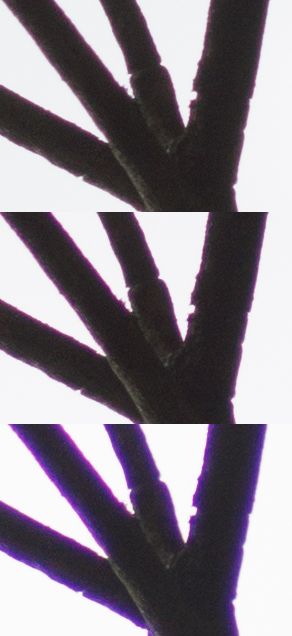= hypercentric
With pericentric lenses objects at larger distances appear larger(!) and objects at closer distances appear smaller.
Perizentric lenses allow for example to view a can from top and the sides at the same time.
This reverses our normal viewing experience.
Pericentric lenses got to be MUCH larger than the object under inspection.
see “comparison: entocentric – telecentric – pericentric”
Application : A cylinder with a drilling that is centered on one circular side and decentered on the opposite side is to be inspected for foreign parts in the drilling.
The rotation of the cylinder is not known, so we would need a
lens that can look from all sides “outside-in” at the correct angle.
Solution: DIY with the help of a Fresnel
Lens, a normal M12
lens and the graphic calculator below …
Purple colored rim around dark objects, typically on a white background

Purple fringing (Image: webfound)
Purple fringing is the visible effect of lateral color-aberrations.
You can imagine this as is one of the Red / Green / Blue Images on a color sensor were a bit too small, for example the blue image. Instead of reaching the white area , together with green and red, it reaches the black area closer to the image center , where no light were expected at all.
That’s why the effect only occurs where (nearly) white and (nearly) black regions meet. If it’s white in a region anyway, it doesn’t matter is all, say, blue) light rays arrive a bit too close to the center, as the “gaps” are filled with other rays. Where black and white areas meet, however, the gaps can’t be filled.
On a monochrome sensor the effect shows as blurry black-white-edges.
The effect is stronger on sensors with smaller pixels, as it’s easier for
ray to arrive in the neighbour pixel.
If a blueish
ray arrives, say, 2.5um closer to the center than red and green rays, it’s no visible problem for sensors of 6um pixels, as we’re pretty much still in the same pixel. On a sensor with 1.67um pixles we fully reached the neighbor pixel already.
